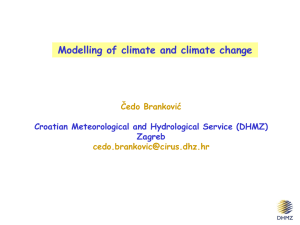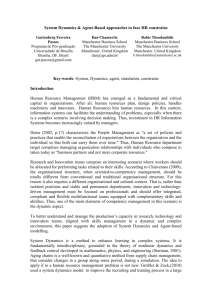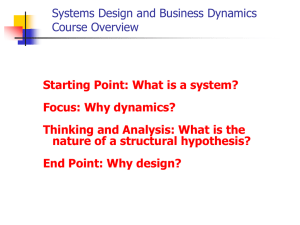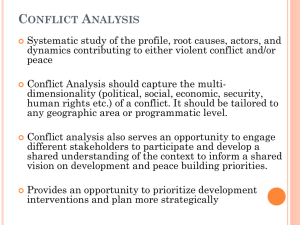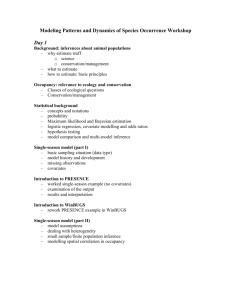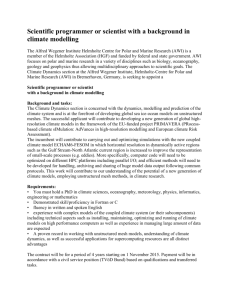The State of a system
advertisement
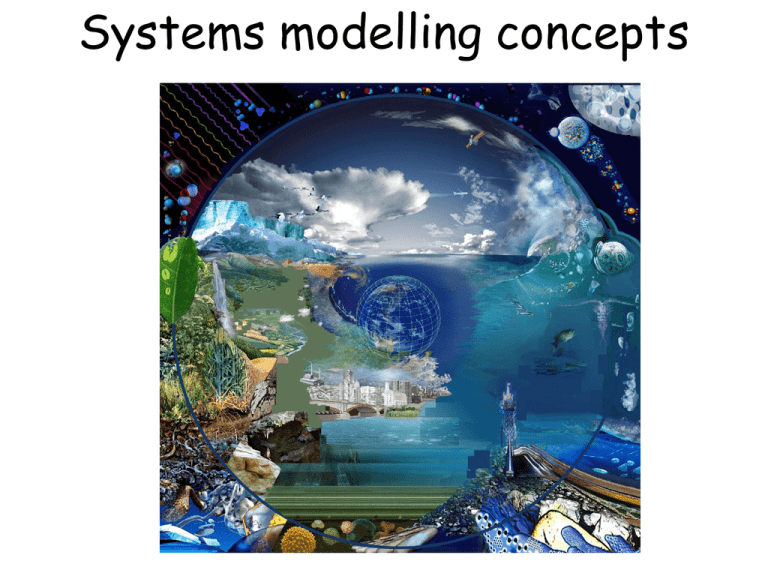
Systems modelling concepts System modelling concepts What is a modelling? Model classification Dynamical Systems System analysis-System dynamics and thinking Introduction to course litterature What is modelling? Mind modelling So, thinking is modelling If the thought is clear and can be communicated, then we can always model it. Modelling is to get an idea of how things are or work. What is a model? A model - a replica - an ideal - to display Dictionary - a simplified representation of the world around us or a material, conceptual or formal representation Book: section1.2 Semi-distributed model HBV SMHI, developed by Sten Bergström and colleagues. g p p0 EXP R T a z A model is: - A model is any understanding which is used to reach a conclusion or a solution -There are no computer models, these are mere mechanical and mathematical translations of mental models -If a model is ’wrong’, then the underlying understanding is wrong The value of models: -Forces us to examine a system carefully and define key variables, relationships, processes, structures and scales -Helps us to understand the functioning -Enables us to extrapolate in – scale and space - future (forecasts) - past(hindcast) -Enables us to interpolate -Allows us to obtain or infer information about unmeasurable variables Models have the potential to: -Quantify expected results -Compare the results of two alternative theories -Describe the effect of complex factors, such as random variation in inputs -Explain how the underlaying processes contribute to the result -Extraplota results to other situations -Predict future events -Translate our science into a form that can be easily used by non-experts Book: section 1.3 Types of models Increasing abstraction Models Scale Hardware Analogue Conceptuel Deterministic Matematical Probabilistic g p p0 EXP RaT z Example; light absorbtion in a canopy Model classification Question Hypothesis Output Input Scope Application Output Qualitative / quanitiative? Deterministic / stochastic? Input Static / dynamic? Scope Descriptive / predictive? Book: section 1.4 Application Functional / mechanistic? Model classification Question Hypothesis Output Input Scope Application Output Qualitative / quanitiative? Deterministic / stochastic? Input Static / dynamic? Scope Descriptive / predictive? Application Functional / mechanistic? Discuss examples: 1. A stylist use a model to suggest what colours dress you best 2. A weather forecast model 3. Betsson (a betting company) needs a model to set odds for which song will win the Eurovision song contest Dynamical systems Systems in the society Football formation system What do they have in common? Education system Transport system Defence system Systems in nature: Isolated system Closed system Energy Isolated system: no exchange with its environment Closed systems: only exchange of energy Open system Open systems: exchange of both energy and matter with its surroundings Matter Systems Representation of a part of reality that is bounded in its surrounding Consist of a number of elements (entities, components) The state of the elements effects each other, which makes the system functioning (or work) Simple Complicated Simple representation of a complicated system Ecosystem: An ecosystem is a biotic and functional system or unit, which is able to sustain life and includes all biological and non-biological variables in that unit. Spatial and temporal scales are not specified a priori, but are entirely based upon objectives of the ecosystem study (Jorgensen & Bendoricchio, 2001) A system: A system is a group of independent but interelated elements comprising a unified whole But: The properties of the whole can only be understood through the interaction and the relationships among the parts within the system + For example: a forest stand In isolation the parts can not be considered as a forest. It is the interaction between the parts that makes it a forest = + A system element: can be specified by its properties (a tree: height, leaf area) The State of a system: the value of relevant properties at a moment in time Process: a (time dependent) relation that changes the state of a system To summarize the characteristics of a system: 1. All descriptions or models of systems are to some extent generalizations, abstractions or idealization of the real world. 2. Systems have some kind of structure or organization of its objects and a boundary. 3. A system is functioning in some way 4 Because it is functioning, there are functional as well as structural relationships between the objects in the structure. 5. The functioning implies some flow and transfer of material or energy through the system 6. This means that there is a driving force, or a source of energy that support the functioning, or drives the system The discipline of System dynamics and system thinking System dynamics = analysis and understanding of the behavior of systems: a methodology for studying and managing complex systems or any feedback system. It uses simulation (computer) models. It is seeing the whole (holism) versus Reductionism System thinking as a discipline for seeing systems as a wholes, it counteracts reductionism looks at relationships between system elements looks at dynamic changes It focus on how the system ’works’: the processes and interrelations – as a mean to understand the system System dynamics Originated in 1960’s from work of Jay Forrester et al of Massachusetts Institute of Technology ’Industrial Dynamics’ (1961), ’Urban dynamics’ (1969) and ’World dynamics’ (1971) System dynamics Other examples Limits to Growt Donella L. Meadows et al, 1972 (World3model) Club of Rome (1968) http://www.clubofrome.org/ Our common future (1987) United Nations World Commission on Environment and Development, headed by Gro Harlem Brundtland, Previous Prime Minister of Norway Informal association of leading long-term thinkers contributing in a systematic interdisciplinary and holistic manner to a better world It targets multilateralism and interdependence of nations in the search for a sustainable development path, and aims to discuss the environment and development as one single issue. Basic elements in system modelling Parameters Constants Variables Flows Stocks Processes Stages in making a model Answer Research question Evaluation Picture Measurements Hypothesis & assumptions Mathematical model Book: section 1.6 Litterature Smith & Smith: Environmental Modelling www.oxfordtextbooks.co.uk/orc/smith_smith/ 1: Introduction (22 Jan) 2: Model Development (30 Jan) 3: Model Evaluation (8 Feb) 4: Application of Models (15 Feb) Litterature Smith & Smith: Environmental Modelling www.oxfordtextbooks.co.uk/orc/smith_smith/
